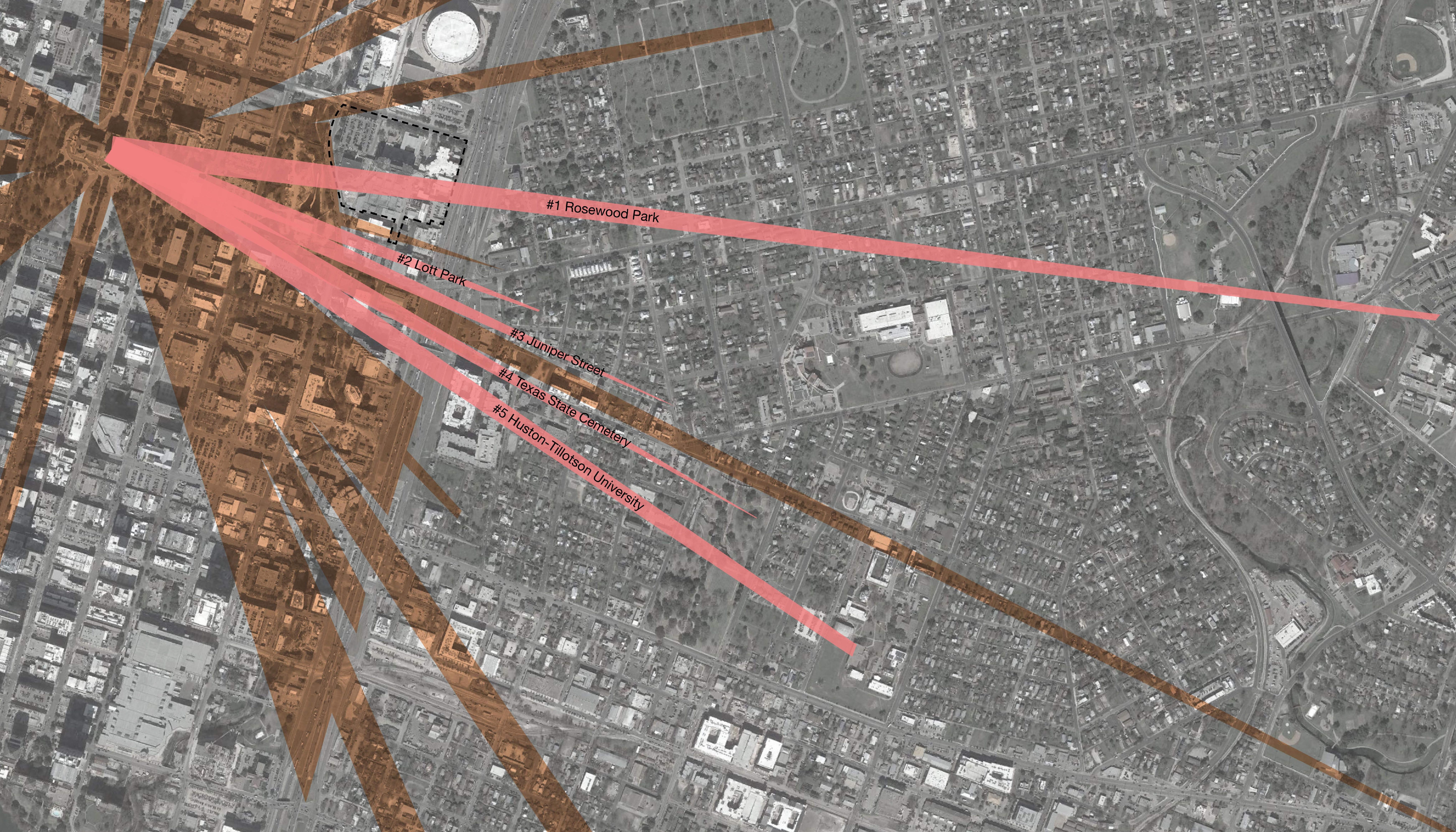Capitol view corridors to compete at Council today
Thursday, February 16, 2017 by
Audrey McGlinchy, KUT Stand atop the hill at the northeast corner of the Texas State Cemetery, and you’ll have a clear view of the Texas State Capitol. It rises alongside a row of trees, now leafless, and a Texas flag. That view, some City Council members say, demands protection.
“This resolution is to preserve the Capitol corridor views that were identified but not enacted in the 1980’s,” wrote Council Member Ora Houston in an email.
Houston’s proposal would add five Capitol view corridors to the 35 existing ones erected by the state and the city. These views are protected lines of sight from which someone can stand on a specific Austin street and make out the Goddess of Liberty – the female figure that caps the Capitol dome.
The current Capitol view corridors stretch into all angles of the city, with nearly one-third reaching east of the Capitol and four extending beyond I-35. Yet despite this, Houston said that her proposal is about ensuring all communities are within eyeshot of the state building.
“It is about equity for the communities that have been disenfranchised and marginalized,” wrote Houston. “The intention is not to interrupt or prevent any specific projects, but to begin the discussion about how we can preserve these views of this one of a kind building from East Austin.”
But those with development plans in the area are not happy – such as Central Health, who last year released a master plan for the redevelopment of the Brackenridge hospital campus, which stretches from 15th Street just west of I-35 to almost 12th Street.
“One of the proposed corridors would go through the southern part of our property,” says Clarke Heidrick, who sits on the Central Health board of managers. According to Heidrick, three blocks of Central Health’s proposed development fall into one of the Capitol view corridors.
But while Heidrick said that Central Health was blindsided by the proposal, so too, he believes, was Houston unaware that the corridors would affect Central Health’s plans.
“I do not believe there was any kind of secret agenda or any kind of hidden activity on her part,” said Heidrick. He said Central Health has been speaking with Houston, and she seems amenable to changing her plans. “I think it surprised her, and it surprised us.”
The proposed corridors could also affect development hopes that Mayor Steve Adler has for eastern portions of downtown. The mayor, who could not be reached for comment, supports the additional Capitol view corridors along with Mayor Pro Tem Kathie Tovo and Council members Leslie Pool and Alison Alter.
Dewitt Peart, CEO of the Downtown Austin Alliance, said restrictions on the height of new development in order to preserve a view of the Capitol could cost the city – literally.
“What we’re seeing is the potential risk of losing that tax increment if these corridors go in place,” said Peart.
Stephen Gibson of Eureka Holdings, which manages owners of multifamily developments in six states including Texas, said the limits that Capitol view corridors place on development is concerning for a city with rising housing costs.
“It simply comes down to math,” said Gibson. “I think if you build more densely and higher, it does things for affordability.”
At least one group has come out in support of Houston’s measure. A letter addressed to the mayor and signed by Benjamin M. Hanson, chair of the Texas State Cemetery Committee, noted the benefit of preserving the view of the state house from cemetery grounds.
“Several of the Cemetery’s most prominent founding fathers have their headstones oriented to the west in order to face the Capitol building,” wrote Hanson. The cemetery serves as final home to Stephen F. Austin and Lt. Gov. Bob Bullock.
Council members will take up the item at today’s meeting.
This story has been corrected. We originally reported the corridors were identified but not enacted in the 1980’s legislature, but it was just the 1980s, so the word “legislature” has been removed.
This story was produced as part of the Austin Monitor’s reporting partnership with KUT.
The Austin Monitor’s work is made possible by donations from the community. Though our reporting covers donors from time to time, we are careful to keep business and editorial efforts separate while maintaining transparency. A complete list of donors is available here, and our code of ethics is explained here.
You're a community leader
And we’re honored you look to us for serious, in-depth news. You know a strong community needs local and dedicated watchdog reporting. We’re here for you and that won’t change. Now will you take the powerful next step and support our nonprofit news organization?






